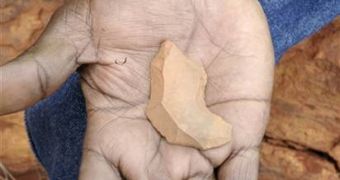America still had to wait for an Ice Age to pass when modern humans entered Australia. Australian Aborigines make one of the world's oldest continuous culture (perhaps just the Bushmen of South Africa are older); some Australian archaeological sites revealed a 40,000-year-old Aboriginal presence. Now, a research team has found 35,000-year-old tools in a rock shelter in northwest Australia, in one of the most arid areas of the continent.
The tools include a flint the size of a small cell phone and hundreds of tiny sharp stones employed as knives. Seeds, bark and other plant material accompanied the tolls at a depth of 6.5 ft (1.95 m) underground. The shelter was a slight crevice in the hillside protected by an overhang of rock, close to an iron ore mine site, about 590 mi (900 km) northeast of Perth, the Western Australian capital.
"This area of land, in regard to our culture and customs and beliefs, is of great significance to us. We have songs and stories relating to that area as a sustaining resource that has provided for and cared for our people for thousands of years," Slim Parker, an elder of the Martidja Banyjima people of Western Australia, told AP.
The archaeologists from Australian Cultural Heritage Management have dug the site between October and February at the request of the local Aborigines, aiming to preserve heritage sites within the mine area exploited by Rio Tinto company.
"Rio Tinto, which had been expanding its Hope Downs mine, halted all work when the rock shelter was discovered. The company will amend its expansion plans to preserve the shelter," company spokesman Gervase Greene told AP.
"The tools included at least one beautifully made piece of flint from which sharp knifelike shards were knocked off, hundreds of tiny knives and pieces of grindstones. Very old sites are rare, and this is one of the oldest in this region. We're filling in a picture of who the first Australians were and what they were doing where they were really, really early," archaeologist Neale Draper, involved in the digging, told AP.
Chemical analysis of the residue found on the knives could reveal what the ancient Aborigines ate. "The team has sent other materials for carbon sampling - including a piece of charcoal - that were found in the dirt layers below the tools. These could be another 5,000 to 10,000 years old, and that would be really exciting. A dozen similar rock shelters in the area will also be excavated," said Draper.
"The find is significant because it confirms that the first people had moved into the more arid parts of Australia earlier than previously known and had adapted and stayed. This appears to significantly extend the date of occupation of the remote Pilbara region. They learned to survive there relatively quickly," said Iain Davidson, an archeology professor at the University of New England in Armidale, Australia.

 14 DAY TRIAL //
14 DAY TRIAL //